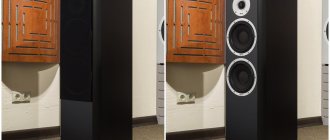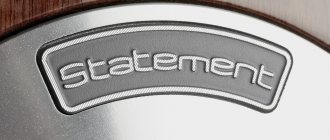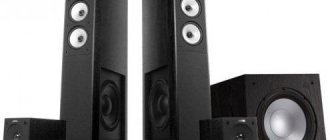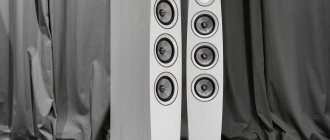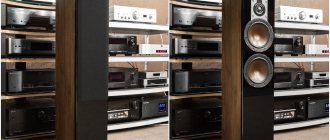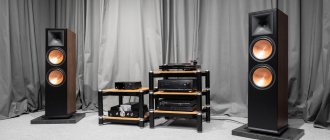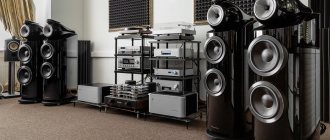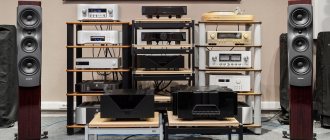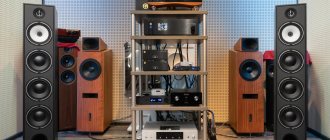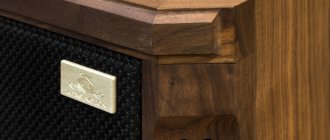The eternal search for a compromise between the sound and appearance of acoustics received an unexpected resolution with the appearance of new speakers from Heco on the market. The Heco Direkt model was first shown at the Berlin IFA exhibition in September 2015, and it has already managed to make a lot of noise in conservative audiophile circles. Judge for yourself: acoustics are initially aimed at people who need everything at once, and for relatively little money. Being aimed at owners of low-power tube and transistor amplifiers, it was loved by almost everyone - music lovers, audiophiles, and most importantly, their loved ones, which, as practice shows, is oh so important.
Style icon
It is no secret that the design of modern technology becomes outdated quite quickly, unless, of course, we are talking about objects that claim to be called “style icons,” which, of course, include the heroes of our today’s review. Is it any wonder, knowing that their appearance was formed in the workshop of Helmut Thiel, a classic of German design who created a number of unique projects, including the famous “red heart” Thorens TD 309. I’ll tell you a secret that I personally enjoy using the headphones he developed , but more on that some other time.
Heco Direkt speaker systems look impressive in any interior
Surprisingly, everyone finds something of their own in the appearance of Heco Direkt. So, Apple fans - the outlines of their favorite gadgets, musicians - the outlines of stringed instruments, car owners - sports stripes and war paint of legendary racing cars. Currently, the speakers are presented on the market in black and white versions, although I must admit, continuing the analogy with sports cars, I would like to see them in fiery red, pistachio or soft coffee color.
Thanks to carefully thought-out forms, Heco Direkt will fit into almost any interior, from palace chambers to extreme youth lofts. And this is not surprising: their concept combined several classic stylistic trends of industrial design.
Technical points
The speaker systems have unusual proportions and are installed at a slight angle on matte silver tripods ending in spikes, which, however, can be fitted with rubber caps. The latter helps to avoid annoying scratches on the parquet, and, if necessary, to correct the sound of the two-port bass reflex port located below. In addition, these stands provide the necessary tilt of the body relative to the listener and their stable placement on almost any surface - from blown antique parquet to raw concrete. For those who are confused by the three-point support, I will say right away that I tried to turn them over, and it turned out to be not at all easy.
Not only the proportions of the buildings and the solidity of the design are noteworthy, but also the quality of the cabinets’ workmanship. I did not see any smudges, traces of glue, polishing defects, or any noticeable seams that attract attention, which are often found in acoustic systems of a much higher price range.
Midrange/woofer – an example of a combination of classic materials and the latest design technologies
Despite the fact that the Heco Direkt externally resembles thin-walled old-school speaker systems, this impression is deceiving. Before us is a completely modern “musical instrument”. The acoustic housings are made of thick MDF panels with stiffening ribs, respectively, massive and inert; tapping the body produces a dull sound.
Two-way speakers with bass-reflex acoustic design. The midrange/bass driver is assembled in a cast aluminum basket - in the best traditions of vintage drivers from the end of the last century. The large 28cm diffuser is made from lightweight and durable Kraft paper. It is driven by a powerful magnetic coil and, thanks to a soft rubber suspension, has a long stroke. The tweeter with a diameter of 28 mm is equipped with a double magnet and a soft textile dome, designed into a small horn.
Textile tweeter housed in a small aluminum horn
Both drivers are coupled to each other at a frequency of 2,350 Hz, are characterized by high sensitivity and were developed specifically for Heco Direkt. The company writes that their modeling used high-precision laser meters, which allowed them to test prototype heads in detail to achieve very low distortion levels. The speakers are protected from dust and external influences by round grills covered with acoustic fabric to match the body.
The relatively large diameter of the midrange/bass driver looks, at first glance, quite strange for a two-way circuit, but the crossover intelligently brings the bands together, and as a result, the impedance curve, according to the datasheet, is almost linear. The result is a seamless, consistent sound. The dual bass reflex port located at the bottom of the front panel is responsible for increasing the output at low frequencies.
The acoustic terminal guarantees a reliable and high-quality connection
To connect to an amplifier, Heco Direkt uses a terminal with one pair of terminals. This may upset some fans of bi-wiring and bi-amping, but believe me, in no case will it negatively affect the sound.
The test path was a McIntosh MCD550 CD/SACD player, McIntosh MA7900 amplifiers, Denon PMA-2500NE, In-Akustik interconnects and speaker wires.
Wideband speaker systems HECO Direkt Einklang
The Direkt retro series, which the German HECO began producing a couple of years ago, already has many fans. Some are captivated by the unique nostalgic design of the speakers, while others are captivated by the grandiose sound of older three-way systems. And who is the newest and most outwardly modest model in the line designed for?
I don’t think that a music lover, seeing Einklang for the first time in an audio salon, will immediately exclaim “Wow, wow!” The new single-lane models are noticeably inferior in size to the earlier Directs, and even more so to the impressive Dreiklang. But despite the modest height and narrowed front panel, Einklang adopted all the design and design features of the series. Front shields covered with matte enamel, for example, are decorated with signature stripes. The front parts, made of MDF, are distinguished by significant rigidity and have recognizable rounded chamfers. They are connected to the remaining walls of the body by internal force struts. Like the older models, there is a bass-reflex acoustic design - two huge pipes are routed into the lower wall of the case. And, of course, the signature feature is in place - three metal slanting legs, guaranteeing the systems the necessary stability. True, you will have to spend a dozen minutes to securely screw them to the cases using the supplied fasteners and tools. By the way, the set also includes spikes that can be used instead of standard silicone supports.
The main diffuser with a very light and movable rubber suspension is pressed from high-strength kraft paper, the recipe of which is still protected by the German company as a military secret.
The key and at the same time absolutely exclusive difference between Einklang and its counterparts was its broadband 21-centimeter emitters. Few people make anything like this today, and manufacturers have only a few heads with such a wide declared range. HECO has invested in them all the know-how accumulated over six decades of development and production of classic cellulose emitters.
The main diffuser with a very light and movable rubber suspension is pressed from high-strength kraft paper, the recipe of which is still protected by the German company as a military secret. The central conical insert in the shape of a horn with a diameter of five centimeters is made of almost weightless low-density cellulose. The optimized shape of this element, combined with a fibrous structure and a concave central cap, as the developer assures, made it possible to achieve uncolored reproduction of high frequencies with minimal frequency response rolloff in the audible range. The driver's voice coil is also lightweight - it is 25 mm, wound from copper-plated aluminum wire on a Kapton frame.
In all such designs, both drivers are mechanically coupled to each other, so achieving linear sound over a wide range is not so easy. To solve this problem, HECO used a two-element magnetic system linearized with a Klippel measuring system. In this way, it was possible to obtain ideal symmetry of magnetic fields and achieve almost complete elimination of eddy currents, which in fact promises minimal distortion. On the basket side, structural mechanical touch-up is also excluded - this cast aluminum frame is carefully calculated for both resonant and aerodynamic characteristics.
Of course, there are no traditional crossover filters in Einklang, but there are several inductors and capacitors in the path that perform correction, phase equalization and compensation functions.
But perhaps the greatest contribution to linearity is made by the crossover. Of course, there are no traditional crossover filters in Einklang, but there are several inductors and capacitors in the path that perform correction, phase equalization and compensation functions. Because of this, the systems have an even impedance throughout the entire operating range and very high sensitivity. They do not place any special demands on the amplifier - even a single-ended tube with a power of five watts or more with any damping factor is enough.
Describing all this, I caught myself thinking that I was engaged in self-hypnosis, apparently fearing further disappointment. More than once I had to deal with wide-range speakers, but there was not a single case where their sound could be at least somehow compared to studio monitors - either there were noticeable dips at the edges of the range, or significant deviations in the middle register, where they are, in my opinion , are unacceptable, or had frankly weak dynamics.
So, believe me, there is neither the first, nor the second, nor the third problem here! I deliberately took an hour-long time-out immediately after I connected the acoustics to the reference amplifier and turned on the “warm-up” music selection, so as not to succumb to the first delight and tune in to a critical perception. But having returned to listening, I was forced to admit that the creators of Einklang still managed to overcome the main vices of the one-way school. The dynamics are very fast, literally crazy! The bass in the working area is “pressing” in a good way and at the same time is not at all weakened in the lowest area. The abundance of the highest components of the spectrum indicated that German broadband providers were also unaware of the decline at HF. Well, and most importantly: the middle register is in complete harmony with the other bands and with itself. Although the main thing here, perhaps, is not the musical balance as a whole, but some kind of mystical animation of everything that is reproduced. It shocks from the first minutes so that the listener, without noticing it, falls into a deep musical trance, where even time flows at a different speed. The last track on the CD finishes playing, but it seems like only five to ten minutes have passed since it was turned on! Where did the other 40 go?
The dynamics are very fast, literally crazy! The bass in the working area is “pressing” in a good way and at the same time is not at all weakened in the lowest area.
You know, for the first time I had to make an effort to “walk” on the edge of this nirvana, focusing my attention on something much less interesting - on the purely technical aspects of sound. By the way, there are enough of them. Let me start with the fact that the perception is dramatically affected by the stereo width and directionality of the systems. You can arrange them so that the musical balance seems most linear by turning the speaker axes slightly away from the listening position, but then the stage is bloated and distorted. Or you can put up with the inevitable HF tint, very similar to a horn, in order to “catch” the proper geometry of imaginary sources. The problem in the first case, by the way, is not so big - space does not turn into a plane, and the images still remain integral and material. But if you are using a laptop as a source, I advise you to take the second route - achieve accuracy in the three-dimensional picture, and overcome nonlinearity with an equalizer, forgetting about all audiophile prejudices. Apple computer operating systems, for example, have a large selection of professional tools that are used in all recording studios around the world. I’ll even tell you what exactly needs to be done: call “audio units”, activate AUNbandEQ and set attenuation at 8700 and 11300 Hz in fairly narrow bands with a level of -4-5 dB. The sound will not only become more accurate and softer, but will also increase in detail, approaching the resolution of film emitters. The mechanism of this phenomenon is simple: by clearing the spectrum of tinting high-frequency interferences (which seem to form on the axis of the composite emitters), we remove the veil behind which much more subtle musical information was hidden.
No other intervention is required. Starting from high bass and up to 4 - 5 kHz, Einklang produces fantastic harmonic resolution, unattainable in multi-band systems due to inevitable phase shifts. At higher frequencies they produce such an abundance of “air”, as if this band was generally reproduced by a hidden super tweeter. The attacking properties need not be discussed at all - the transmission of fronts is extremely integral, in an instant the listener’s brain recognizes the origin, strength and timbral character of the sound image.
Starting from high bass and up to 4 - 5 kHz, Einklang produces fantastic harmonic resolution, unattainable in multi-band systems due to inevitable phase shifts.
In view of the above, Einklang are also sensitive to all changes in the path, like, for example, very expensive magnetoplanar or electrostatic speakers. I judge this by very simple criteria. It turns out that there can be not just some differences between normal and Pure mode in a top-notch CD player, but a huge difference. And switching an integrated device with a built-in DAC to Analog Mode can lead to amazing clarity in conveying the “breath” of a concert hall. Therefore, if you have already had your eye on Einklang, psychologically prepare yourself for the fact that you will most likely have to take a fresh look at the entire “system structure”. And at the same time - and the chronic lack of 25th hour in the day to listen to your favorite music.
SYSTEM
- Sources Denon DCD-2500NE player
- laptop Apple MacBook Air A1465
- interconnect InAkustik Referenz NF-2404 RCA
Speaker systems HECO Direct Einklang
Manufacturer: Magnat Audio-Produkte GmbH (Germany)
www.heco-audio.de
Configuration: 1 emitter, 1 strip || Acoustic design: bass reflex || Frequency range: 32 - 19,200 Hz || Sensitivity: 94 dB || Resistance: 4 - 8 Ohms || || Recommended amplifier power: 5 – 180 W || Finish: black or white || Dimensions: 382 x 842 x 196 mm (382 x 931 x 385 mm with supports) || Weight: 19 kg || Price per pair: 149,000 rub.
share
Tags: Direkt EinklangHECOExpert's choice
Correct division
According to the good old tradition, to test the acoustic systems, I used the time-tested, well-known CDs “In the Mood of Giya Kancheli” and “Lullabies of the Hills”. The first allows you to hear even minor resonances and other overtones, the second contains ethnic music, flawlessly recorded from two microphones, like a litmus test, revealing the slightest artificiality in the presentation of musical material.
The legs of the speaker systems are equipped with spikes and rubber caps, allowing you to fine-tune the sound
The first thing you notice is that Neso plays right out of the box, and even with a slight turn of the volume knob, they do not lose enthusiasm, sounding full-bodied and rich. The sound flows easily and effortlessly. The high sensitivity of the speaker systems allows you not to miss small details. Of course, they are designed to work even with low-power tube and transistor amplifiers. During the listening, there was no desire to dissect the sound by frequency and shout like Stanislavsky, “I believe” or “I don’t believe.” I just wanted to listen and didn’t want to finish testing.
Dustproof nets with magnetic fasteners are made to match the housings
The acoustics play very quickly and transparently, the images it forms are physical, accurate and correctly separated from each other. I had previously heard such a sound “arrangement” only from acoustics with orthodynamic drivers, and I did not at all expect such a result from traditional electrodynamic speakers.
The bass is not just audible, it is literally physically felt. However, despite the visual reference to retro, it does not feel the heavy, bravura tread of a significant number of German acoustic systems of the 60s-70s, sounding reminiscent of army horses pulling a cannon. The vocals and sound of ethnic musical instruments are vivid and almost tangible.
The reproduction of complex orchestral works also did not cause any complaints. The sound does not “stick” to the speakers; virtual sources are perfectly localized in space and do not merge into mush. The frequencies are glued together seamlessly and organically.
The bass reflex port located on the bottom panel provides deep low frequencies
At some point I had the feeling that I was listening to reference full-range speakers with bass and high frequencies unattainable for them. This phenomenon is partly explained by the specific tilt of the body, which makes it possible to enhance the effect of phase-linearity and consistency of the sound of the dynamic drivers.
The directional pattern of Heco Direct is wide enough so that, when moving around the room, the listener does not experience discomfort from sudden changes in the stereo panorama.
During the listening, both test amplifiers easily coped with the task, playing the proposed material without any comments. The Heco tandem with McIntosh MA7900 was remembered for its surprisingly accurate presentation with a certain touch of academic snobbery. At the same time, in combination with the Denon PMA-2500NE amplifier, the speakers sounded a little more impressive and liberated, fully demonstrating the Denon signature musical signature, beloved by many.
The latest HECO Direkt Einklang perfectly complements HECO's exceptional Direkt line of loudspeaker systems. Like Direkt and Direkt Dreiklang, it represents a completely independent and almost absent concept on the market: HECO Direkt Einklang is an exclusive single-way system based on one (!) full-range speaker, working as a point source of sound and ensuring maximum reliability and accurate transmission of space.
The low mass of the moving system allows for high sensitivity, which makes the HECO Direkt Einklang an ideal speaker for combination with both tube amplifiers with a power of 5 W or more, and with powerful transistor amplifiers. HECO Direkt Einklang, as a member of the high-end Direkt line, stands out with its elegant silky matt lacquer finish with contrasting double stripes and high-quality and exclusive components that have been specially developed and perfectly optimized individually for this speaker.
The centerpiece of the HECO Direkt Einklang is the full-range 210mm loudspeaker. Like its predecessors, this speaker was also equipped with a specially designed driver that was optimized technically and acoustically, using all the resources available to HECO engineers. The speaker is based on an extremely lightweight kraft paper cone. There is no need for complex filters in combination with a lightweight diffuser, allowing for high resulting speaker sensitivity of up to 94dB.
HECO's wealth of nearly 70 years of engineering experience is evident in the specially designed tweeter cone with its new NAWI shape and inverted dust cap. The cone is made from a single piece of material consisting of a particularly stiff and lightweight paper compound that provides natural and accurate high frequency reproduction. Drive is provided by a powerful dual magnet system that features a highly reliable, weight-optimized 25mm CCAW voice coil. Any distortion in the mid and high frequencies is minimized thanks to impedance compensation. Optimized using Klippel's high-tech measurement system for perfect symmetry and minimal distortion, the driver features a durable cast aluminum basket with narrow aerodynamic struts and multiple vents.
The extremely robust and flat housing of the HECO Direkt Einklang is made from MDF with reinforced baffles and has low resonance and excellent anti-vibration properties. The design is equipped with a dual-port FI system with bi-directional optimized air flows and rounded holes at the ends, guaranteeing maximum efficiency in the low-frequency range. Like other models in the Direkt series, the Direkt Einklang is also equipped with a specially designed metal podium. The wide baffle and large cabinet volume are another cornerstone of the excellent acoustic performance of the HECO Direkt Einklang.
Authentic and dynamic sound with fast, powerful bass, vibrant midrange and detailed and airy highs with superb spatialization. What you expect from the HECO Direkt range.
Fun acoustics without genre preferences
The speakers do not have clearly defined genre preferences, however, in my opinion, they are more suitable for a passionate music lover who tends to focus on the quality of the musical material, rather than for an audiophile who splits music into atoms in order to hear the equipment on which it sounds. In addition, they can easily cope with the tasks required of home entertainment equipment. Usually you expect this kind of sound, along with vivid impressions, from acoustics in a much higher price range.
In white, the speakers look especially unusual, as if floating in the air
I note: to reveal the capabilities of these speakers, you will have to forget about low-quality recordings, which make up a significant part of any home music library. The acoustics reproduce all the nuances of the recording verbatim, and if these nuances are of low quality, they are clearly audible. In addition, the design of Heco Direkt is so unusual that against their background the interior of the room may seem boring and you will want to update it.
Advantages: High sensitivity. Genre versatility. Memorable appearance.
Disadvantages: Slight emphasis on mid frequencies. Limited color palette.
Price (recommended): 239,900 rubles
